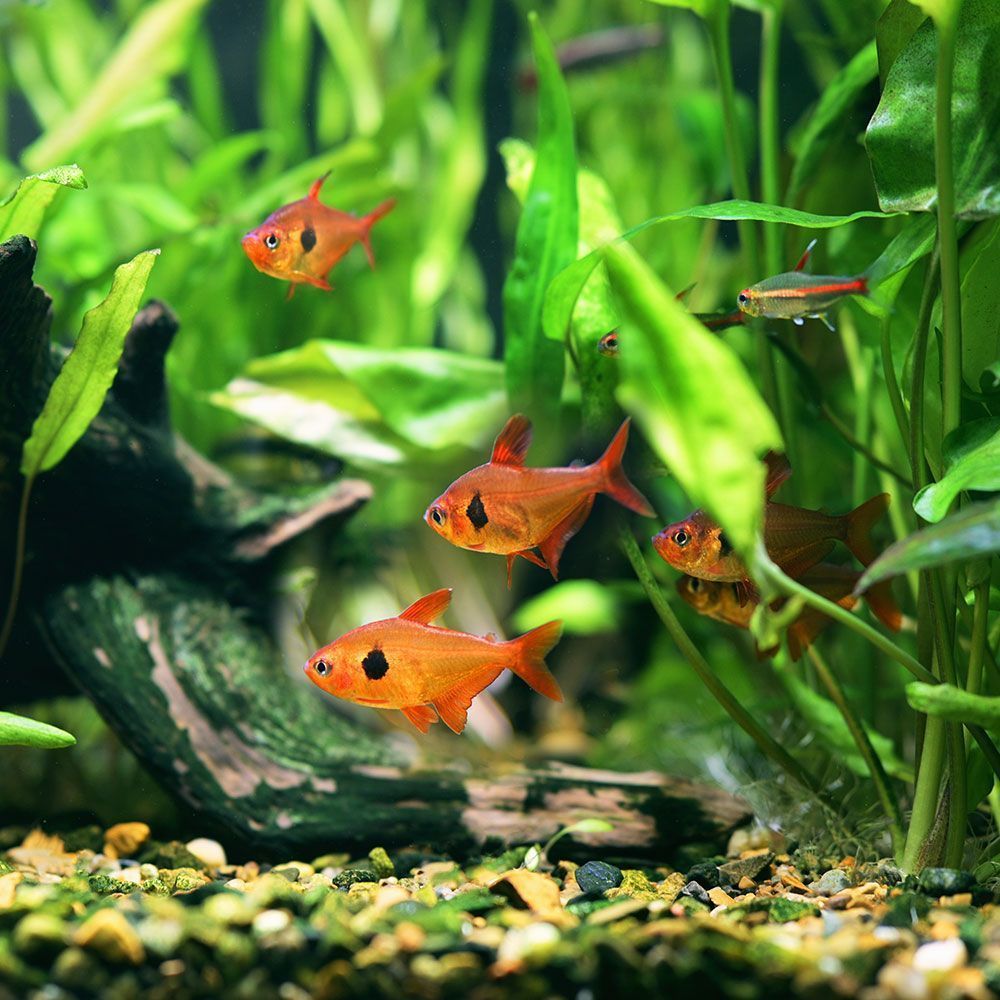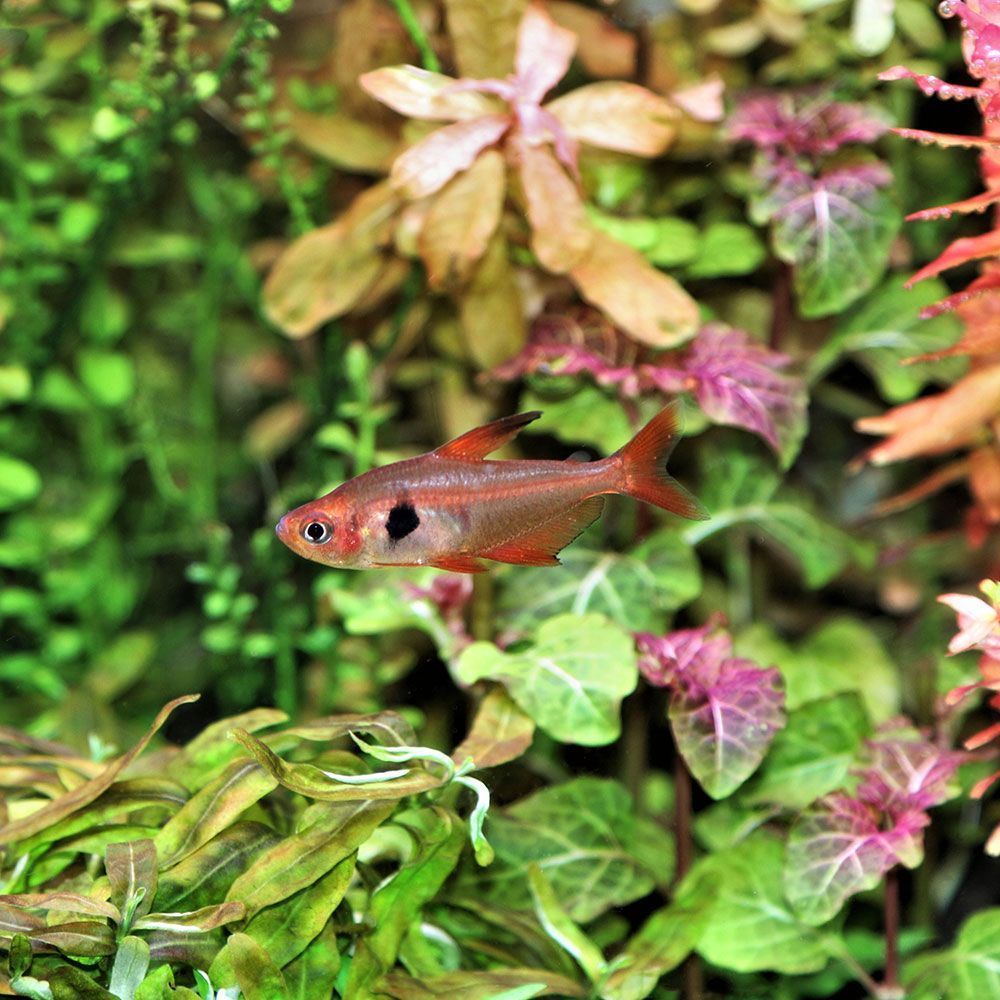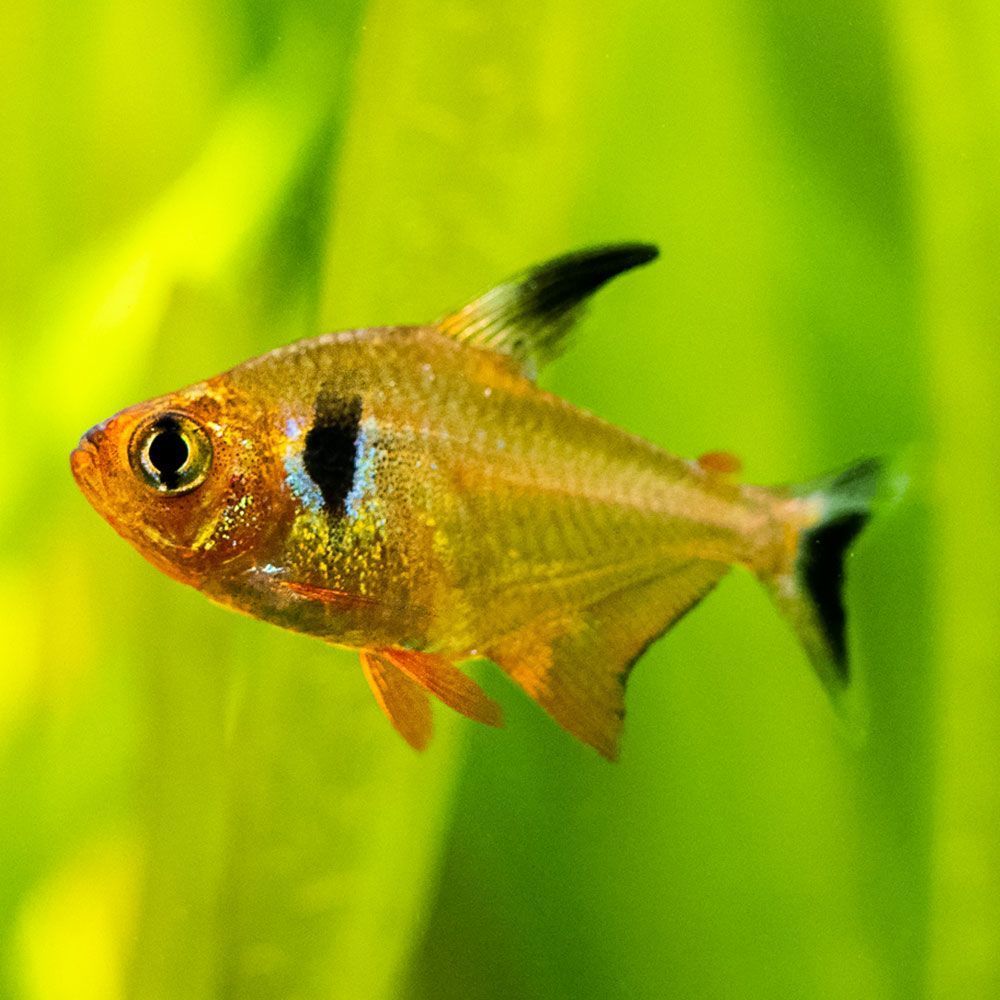If you want a pop of bright and head-turning color in your tank, red phantom tetra should be on your list. It’s a super friendly fish, suitable for all beginner’s tanks.
The fish is low-maintenance, eats almost everything, and is playful and expressive.
If you want to bring it home, get down to the details!
What are the Characteristics of Red Phantom Tetra Fish?
| Origin | Orinoco River basins, South America |
| Order | Characiformes |
| Family | Characidae |
| Scientific Name | Hyphessobrycon sweglesi |
| Common Names | Red phantom tetra, Swegle’s tetra |
| IUCN Red List Status | Least Concern |
| Appearance | Red translucent body, red fins and tail, a black blotch on the ventral side |
| Size | Up to 3.0 cm (1.18 in) |
| Lifespan | Up to 2-3 years; 5 years with optimal care |
| Temperament | Peaceful, but nips at much smaller fish |
| Tank Level | Top and middle-level dwellers |
| Water Temperature | 70-80 °F (20-27 °C) |
| pH Level | 6.5-7.5 |
| Water Hardness | 4-20 dGH |
| Care Level | Easy |
| Minimum Tank Size | 25 gallons for 10 of them |
| Tank Environment | Mature, vegetated tank with lots of swimming space |
| Diet | Omnivorous |
| Tank Mates | Peaceful, similar-sized fish without long or delicate fins |
What is the Natural Habitat of Red Phantom Tetra Fish?
Red phantom tetras are native to the freshwater basins of the Orinoco River of South America. It mainly covers the tropical regions of Brazil, the mainland of Colombia, the Bolivar of Venezuela (mainland), Ecuador, and Peru. It also inhabits the oceanic benthopelagic zone.
It was assessed Least Concern by The IUCN Red List of Threatened Species in 2020.
Which family does Red Phantom Tetra Fish come under?
The fish is classified under the Characidae family of the Characiformes order. Currently, its taxonomic name is Hyphessobrycon sweglesi. But it was also known as Megalamphodus sweglisi in the past.
In the global aquarium trade, it is popular by two names: red phantom tetra and Swegle’s tetra.
Fun Fact: It is a slow swimmer and is extremely shy when young. But once it grows into an adult, it becomes much more active, swims fast, and socializes with fellow tank mates.
How does a Red Phantom Tetra Fish look?

Like most other tetras, red phantom tetras are bilaterally symmetrical, diamond-shaped, and laterally compressed. For more details, keep reading.
What is the Size of Red Phantom Tetra Fish?
In captivity, the standard length of the male adult fish is up to 3.0 cm (1.2 in). But in the wild, it can be 3.2-4.0 cm (1.3-1.6 in). Due to its small size, it is often grouped under dwarf aquatic animals.
What is the Color of Red Phantom Tetra Fish?
The fish has an overall clear bronze to red colored body and fins. Around its stomach, right behind the gill plate on the ventral side, there’s a black blotch. The fins and tails are orange-red like its eyes’ upper rim.
You’ll notice a red line on its head connecting the mouth and eyes, and a black line runs across its eyes, which makes it very prominent.
Is Red Phantom Tetra Fish available in a Morph?
The species is also available in its albino form and lacks the red sheen. It’s almost transparent with a tinge of beige-orange around the lateral line and the fins are also orange.
Novice aquarists assume that it also has other morphs – like yellow phantom tetra and black phantom tetra. But those are entirely different tetra species – Hyphessobrycon roseus (Rosy tetra) and Hyphessobrycon megalopterus (Black phantom tetra), respectively.
What are the Features of Red Phantom Tetra Fish?
The overall body has red scales and is almost translucent and glowing. The fish can dim its color when stressed to avoid attention from predators.
In an unstable water pH, it often turns dull grey or even black. Poor water conditions can also limit its development.
The fish’s auditory system includes its swim bladder and otoliths, which results in a 200-2000 Hz hearing range and 70 dB hearing threshold.
Its mineralized tissue consists of hydroxylapatite and aragonite, and its mineralized skeleton comprises apatite.
How is male and female Red Phantom Tetra Fish different?
The body of the male fish is slightly longer than females. Males also have longer dorsal and anal fins than females.
The female is smaller yet much more deep-bodied. Females also flaunt a black band on their dorsal fin, which is absent in males.
What is the Behavior & Temperament of Red Phantom Tetra Fish in the tank?
The fish is peaceful and shy, but if kept in smaller groups or if its swimming space is crowded, it might nip other fish’s fins.
What is the Lifespan of Red Phantom Tetra Fish?
Beginner aquarists can only sustain the fish for 2 to 3 years only due to their lack of expertise in water parameter maintenance. But according to my experience, it can live up to 5 years with the best care.
Author’s Note: The male red phantom tetra may also become aggressive during the breeding season to show dominance. The males of this usually gregarious species may even fight among themselves to be the chosen mate. Don’t worry, as this fight won’t cause major wounds.
How to take care of Red Phantom Tetra Fish?

To ensure that your pet fish accompanies you for the longest time possible, follow every little thing here!
What is the Tank Size suitable for Red Phantom Tetra Fish?
As it’s a schooling fish, you need to keep a group of them together. Keep a minimum of 10 together in a 25-gallon tank. Thereafter, for every extra fish you add, increase the tank size by 3 gallons minimum.
What is the Water Chemistry needed for Red Phantom Tetra Fish?
The fish is extremely sensitive when it comes to the water parameters. So, take care of its health by maintaining these numbers.
- pH Levels: 6.5-7.5
- Water Temperature: 70-80 °F (20-27 °C)
- Water Hardness: 4-20 dGH
- Ammonia: 0 ppm
- Nitrite: 0 ppm
- Nitrate: Below 30 ppm
What is the Tank Environment required for Red Phantom Tetra Fish?
The best way to make your pet happy is to mimic its Amazonian biotope. For that, follow these:
1. Substrate
Opt for a dark-colored sandy substrate to diffuse the light, keep the shy species comfortable, and also show off its best colors.
2. Plants
Put dense plants on the aquarium sides and bottom. This will create a perfect hiding spot when the red phantom tetra feels insecure. You can choose from Java fern, Amazon swords, and Anubias.
However, make sure that this doesn’t interfere with its swimming space. You can also introduce floating plants to cut off direct light in the tank.
3. Lighting
Use the dimmest lights you can get your hands on. Bright light may stress the fish, but darkness may cause inactivity and loss of appetite. Keep the lights on only for 14 hours at most to induce the fish to sleep at night.
4. Décor
Use bog roots or driftwood and dried leaves to acidify the water and stain it with tannins. Introduce rock or wooden hiding places. Dry leaves also promote microbe growth, a great food source for your red phantom tetras. You can also add corals and caves,
5. Filtration
The fish is extremely sensitive to toxins, so to maintain a healthy ecosystem, install a reliable yet gentle filtration system.
6. Water Flow Rate
Since the fish appreciates a slow or nearly-stagnant water flow, you must also mimic the same in your tank.
Fish Care Tip: Monitor water parameters once or twice weekly to avoid unstable conditions and help the fish live longer.
What does Red Phantom Tetra Fish eat?
Since the fish is omnivorous and not picky, it can thrive on various foods, including dry, fresh, live, and frozen. Just ensure you always keep it on a balanced, high-quality diet so the fish exhibits its best colors.
Some great dietary components are:
- Flakes
- Granules
- Pellets
- Small invertebrates
- Crustaceans
- Chopped microsized fruits and veggies
- Filamentous algae
- Bloodworm larvae
- Brine shrimp
- Mosquito larvae
- Mud Worms
- Red daphnia
- Moina
Unlike other tetras, you must only feed the fish once. Make sure it’s enough to avoid getting excess food piling in the tank. Otherwise, it may rot and lead to diseases.
Which Tank Mates are required for Red Phantom Tetra Fish?
Before you add more tank mates, make sure there are at least 10 of the same species together. Once you notice the tank can accommodate more, you can choose other species.
The fish is friendly towards most similar-sized, similar-tempered, shoaling fish. Some examples are:
- Dwarf cichlids
- Small callichthyidae
- Characids
- Small corydoras (bronze cories)
- Loricariids
- Harlequin rasboras
- Livebearers
- Lebasinids
- Rainbowfish
- Similar-sized similar-tempered tetras (head and tail light tetra, black phantom tetras)
- Long fin super red bushynose
- Gasteropelecidae
- Mollies
- Guppies
- Platies
- Danios
- Swordtails
- Barbs
- Similar-sized invertebrates
You must also choose tank mates that mainly swim in the bottom to middle levels.
Which Tank Mates to Avoid for Red Phantom Tetra Fish?
It nips the fins of other fishes when stressed, so avoid species that have delicate long fins like these:
- Bettas
- Gouramis
- Freshwater angelfish
Smaller species may become its snack-meal, so avoid putting them together with:
- Juvenile shrimp
- Small and baby snails
You must also avoid:
- Aggressive tank mates (Oscars, tiger barbs, arowanas, red-tailed sharks): red phantoms will feel insecure and get stressed with them
- Bigger species: Your tetras might become the dinner meal for these
What are the Common Diseases for Red Phantom Tetra Fish?
The fish is hardy but not resistant to diseases. So, always be cautious about signs of possible diseases, like…
| Disease Name | Causes | Symptoms | Treatment |
|---|---|---|---|
| Ich | Parasitic protozoan infection | Flashing, white spots, inactivity, appetite loss | Raise tank temperature, add aquarium salt or ich medicines |
| Columnaris | Bacterial infection | Grey or white patches, fin fraying, inactivity, appetite loss | Enhance water quality, lower stress, give antibiotics |
| Fin and tail rot | Bacterial infection | Discolored or red streaks on fins, frayed and disintegrated fins, inactivity, appetite loss | Improve water quality, get rid of physical injury sources, antibiotics |
| Velvet | Parasitic infection | Color loss, flashing, harsh and quick breathing, clamped fins, inactivity, appetite loss, peeling skin, yellow coat on skin | Elevate water temperature, dim lights for some days, add aquarium salt or medicine |
| Flukes | Parasitic infection | Scale loss, red spots, overproduction of mucus, inactivity, appetite loss | Oral medicines, injections, medicated baths |
| Red pest disease | Bacterial infection | Red or pink streaks on the body, fins, tail, and scales, overproducing mucus, inactivity, appetite loss | Enhance water quality, perform a water change, reduce crowding in tank, maintain a better diet, add aquarium salt |
| Swim bladder disease | Constipation, overeating | Irregular swimming pattern, inactivity, appetite loss | Feed lesser, feed boiled and skinned peas |
| Neon Tetra disease | Microsporidian parasitic infection | Color fading, hyperactivity, lumpy flesh, curved spine, irregular swimming patterns, fin rot | Incurable. Try methylene blue. Prevention is better than curing |
| Aspergillosis | Fungal disease | Gill erosion, fin damage, lesions | Antibiotics, speak to a vet, feed a healthy and high-quality food |
| Giardia | Fungal infection | Bloating, loose stool, inactivity, appetite loss, fish turning thin overtime, flashing | Regular water change, quarantine fish, antibiotics |
Quick Tip: Red phantoms are highly susceptible to diseases. So, always introduce the fish only after you create an established and steady tank. Also, quarantine any new fish before adding them to a community tank.
How to Breed Red Phantom Tetra Fish?
The fish randomly spawns, so reproduction is not tough in this species, unlike other tetras. However, the main issue is the fry growth.
The female fish is an egg-scatterer, and parents show no care towards their fry. The adult fish might even consume its own fry.
So, if you want to increase the chances of young red phantoms, set a separate smaller tank for spawning and fry growth.
What is the Tank Preparation needed for Red Phantom Tetra Fish?
Get a 20-gallon tank and prepare it with the following:
- Sponge filter with oxygenation power and slow water movement
- Dim lighting and add floating plants to make the aquarium even darker
- Spawning mops or plants with flat and smooth surfaces to catch the eggs
- Mesh on the base so eggs can fall through it, but adults can’t pass through
Build a tank with mature water of the following parameters:
- Temperature: 75 °F (24 °C)
- pH: 6.0-6.5
- Water Hardness: 5 dGH
Spawning Induction
Condition the adult fish group or pair it with a healthy diet. Make sure the fish is at least 8-12 months old, as that’s when they become ready to reproduce.
In the evening, introduce a mated pair or a group with more females than males. This will reduce the chances of fights over dominance assertion.
The male chases the female and bounces on her body. If the female feels impressed, she scatters 100-200 eggs which get stuck to different tank objects. The male then fertilizes those. The fish usually mates by the next morning.
So, in the morning, look for brown-to-red eggs. Remove the parent fish once you notice it.
How does Fry Development for Red Phantom Tetra Fish take place?
Block off all light sources as it lengthens the incubation period and fry growth. After 1-3 days, the eggs hatch, and the fry feeds on their yolk sacs. By the 6th day, the fry can freely swim, but they usually stay hidden.
From the 10th day, feed the fry baby brine shrimp, micro fry food, crushed flake food, micro worms, cyclops, or infusoria for about one and a half months.
Increase water hardness and add little light to help the fry get accustomed. You must also perform weekly water changes and maintain a stable environment throughout the growth.
Breeding Tip: Pay extra attention to the eggs during the incubation phase and remove any parasite-infested eggs ASAP. Note: Infested eggs have a white coating.
For any kind of live food, only feed the fry home-cultivated food to avoid introducing diseases in your breeding tank.
How to Buy Red Phantom Tetra Fish?
The fish is often confused with its look-alike Serpae tetra (Hyphessobrycon eques), which has a poor reputation for being nippy and rowdy. So, look closely while buying this fish, or other tank mates might get in trouble.
A word from FishInAquarium
A group of red phantom tetras are pleasant to the eyes and add a splash of color to your freshwater tank. But that’s not it. The species also helps any beginner-level aquarist to progress to an intermediate level with its expressive nature.
So, if you found all that interesting and feel ready to house them, share them with fellow aquarists. And if you believe there is more to know, remember we are just a mail away!


